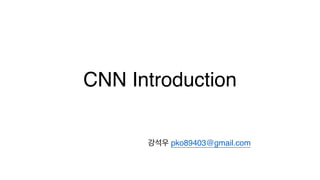
CNN Introduction
- 2. Convolution ( 합성 곱 ) 하나의 함수와 또 다른 함수를 반전 이동한 값을 곱한 다음, 구간에 대해 적분하여 새로운 함수를 구하는 수학 연산자
- 3. 가로 32, 세로 32의 이미지 데이터를 학습 하려면 ? • Fully-Connected로 학습 하기 위해 32 * 32 * 3 = 3072개의 weight, bias 가 필요하다. • ConvNet의 레이어는 가로, 세로, 깊이 3개의 차원을 가진다.
- 4. Convolutional NN은 3가지 Layer로 구성될 수 있다. • 1. Convolutional Layer • 2. Pooling Layer • 3. Full—Connected Layer
- 5. Convolutional Layer • parameter를 가지고 가로, 세로 그리고 깊이 의 차원을 가진다. • forward pass 때에는 • 각 필터를 convolve 시키며 2차원의 activation map을 생성한다. • 필터와 입력 요소 간 내적 (dot product) 으로 특정 위치의 패턴에 반응하는 active 필터를 학습한다. • activation map을 깊이로 쌓은 것이 출력이 된다. + stride 로 겹치는 영역을 조절 + padding 로 공간적 크기를 조절
- 6. Pooling Layer • 일반적으로 Convolution Layer 사이에 넣 는다. • 네트워크 연산량을 줄이기 위해 공간적인 크 기를 축소 한다. • Backward 하기 위해서는 forward에 한 행 동을 기억해야한다. • Average Pooling < Max Pooling • Fractional Max Pooling • Normalization Layer ? ( 실제 두뇌 ) • Overfitting ? Pooling 꼭?
- 8. 1D, 2D, 3D Convolution Moving 1 Dimensional Conv 2, 3 Dimensional Convolution
- 9. 3D Convolutional Networks • 시공간 특성을 가진 데이터에 적용을 하기 위해 • 2D -> Spatial, 한 차원↑→ SpatioTemporal( 시공간 ) Volume 이 된다 수학적 비교 https://ai2-s2-pdfs.s3.amazonaws.com/3c86/dfdbdf37060d5adcff6c4d7d453ea5a8b08f.pdf 참고사이트 https://jay.tech.blog/2017/02/02/3d-convolutional-networks/ TEMPORAL